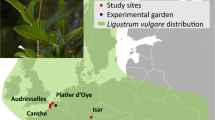Abstract
Different types of incompatibility systems were found to operate simultaneously in alnus glutinosa in the course of numerous pollination experiments, including self-pollination and pollination with controlled pollen mixtures. Isozyme genetic markers were used to identify the pollen parent of each offspring from the mixed pollination experiments, thus allowing specification of the fertilization success of each pollen parent. In a first step, these results were compared with observations on in vitro pollen germination experiments. This comparison allows for exploration of the explanatory value of different germination media as models of germination conditions on stigmas. In most cases, the data suggest that the in vitro germination conditions resemble the fertilization conditions in vivo, at least in the sense that they favor the same pollen parents. By providing a generic and operable definition of the two basic types of incompatibility, eliminating (inability to fertilize ovules) and cryptic (resulting in lowered fertilization success of a pollen parent under competition), evidence was detected for the existence of both types of incompatibility in alnus glutinosa, where eliminating incompatibility occurred as self-incompatibility only. However, since this incompatibility seems to act primarily via pollen elimination, seed production is not likely to be negatively affected in natural populations, even for comparatively large amounts of self-pollination.
Similar content being viewed by others
References
Bateman, A.J., 1956. Cryptic self-incompatibility in the wallflower: Cheiranthus cheiri L. Heredity 10: 257–261.
Bertin, R.I. & M. Sullivan, 1988. Pollen interference and cryptic self-fertility in Campsis radicans. Am. J. Bot. 75: 1140–1147.
de Nettancourt, D., 1977. Incompatibility in Angiosperms. Monographs on Theoretical and Applied Genetics 3. Springer, Berlin etc.
Finney, D.J., 1952. The equilibrium of a self-incompatible polymorphic species. Genetica 26: 33–64.
Gregorius, H.-R., 1974. Genetischer Abstand zwischen Populationen. I. Zur Konzeption der genetischen Abstandsmessung. Silvae Genetica 23: 22–27.
Gregorius, H.-R., 1989. Characterization and Analysis of Mating Systems. Ekopan, Witzenhausen (Germany).
Gregorius, H.-R. & B. Degen, 1994. Estimating the extent of natural selection in seedlings from different Fagus sylvatica (L.) populations: Applications of new measures. J. Heredity 85: 183–190.
Hagman, M., 1970. Observations on the incompatibility in Alnus. pp. 1–19 in Proc. IUFRO Sect. 22 Working group meeting — Sexual Reproduction of Forest Trees, edited by The Finnish For. Res. Inst. Helsinki 1.
Hagman, M., 1975. Incompatibility in forest trees. Proc. Roy. Soc. London B 188: 313–326.
Heitmüller, H.-H., 1957. Die Selbstungsanalyse als Möglichkeit der Kombinationsprüfung bei Kreuzungen innerhalb der Gattung Alnus. Silvae Genetica 6: 158–159.
Holzer, K., 1961. Der derzeitige Stand der Auswahl von Schwarzerlen und von Zirbe im Rahmen der Forstpflanzenzüchtung. Forstliche Bundesversuchsanstalt Mariabrunn in Schönbrunn, Informationsdienst. Allg Forstzeitung (Beilage) 72: 21.
Johnsson, H., 1951. Lövträd. pp. 759–827 in Svensk Växtförädling, II, Trädgårdsväxterna, Skogsväxterna. Natur och Kultur, Stockholm.
Kanchan, S. & Jayachandra, 1980. Pollen allelopathy — A new phenomenon. New Phytol. 84: 739–746.
Linares Bensimón, C., 1984. Versuche zur Viabilitätsselektion an Enzym-Genloci bei Alnus glutinosa (L.) Gaertn. Göttingen Research Notes in Forest Genetics 7, 137 pp.
Marshall, D.L., M.W. Folsom, C. Hatfield & T. Bennett, 1996. Does interference competition among pollen grains occur in wild radish? Evolution 50: 1842–1848.
McCubbin, A.G. & T.-H. Kao, 1996. Molecular mechanisms of self-incompatibility. Curr. Opin. Biotech. 7: 150–154.
Mulcahy, D.L., G.B. Mulcahy & E. Ottaviano (eds), 1986. Biotechnology and Ecology of Pollen. Proc Int Conf Biotech Ecol Pollen. Amherst, MA, USA. Springer, New York etc.
Murphy, S.D. & L.W. Aarssen, 1989. Pollen allelopathy among sympatric grassland species: In vitro evidence in Phleum pratense L. New Phytol. 112: 295–305.
Rohmeder, E. & H. Schönbach, 1959. Genetik und Züchtung der Waldbäume. Paul Parey, Hamburg Berlin, 338 pp.
Steiner, W. & H.-R. Gregorius, 1998. In vitro pollen germination experiments in Alnus and their relevance for mating system analysis. Forest Genetics 5: 47–60.
Weisgerber, H., 1974. First results of progeny tests with Alnus glutinosa (L.) Gaertn. after controlled pollination. Proc. Joint IUFRO Meeting S.02.04.1–3. Session VI. Stockholm.
Weiss, M., 1964. Möglichkeiten einer züchterischen Verbesserung der heimischen Erlenarten, insbesondere der Schwarzerle — Alnus glutinosa (L.) Gaertn. Dissertation TU Dresden (Tharandt).
Author information
Authors and Affiliations
Rights and permissions
About this article
Cite this article
Steiner, W., Gregorius, HR. Incompatibility and pollen competition in Alnus glutinosa: Evidence from pollination experiments. Genetica 105, 259–271 (1999). https://doi.org/10.1023/A:1003859030320
Issue Date:
DOI: https://doi.org/10.1023/A:1003859030320




